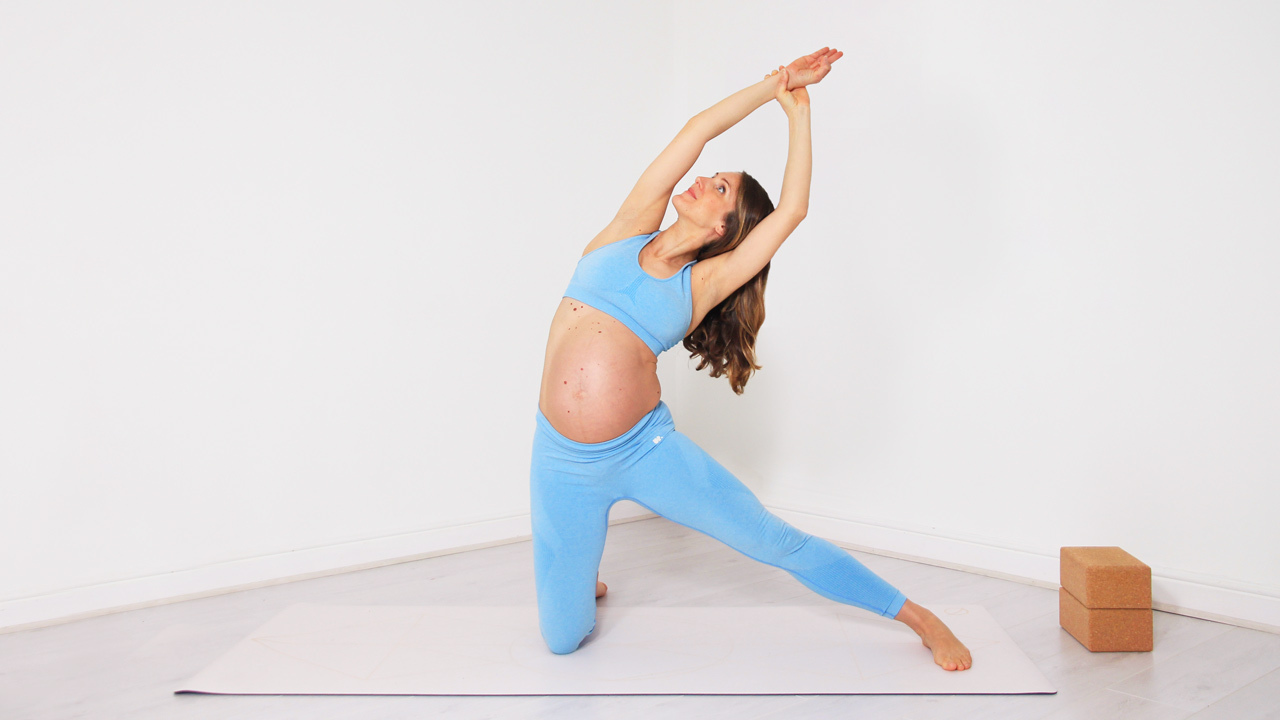If you have an established yoga practice and become pregnant, how can you can you make sure what you are doing is appropriate for your changing body? For the answer to this question, and many more, read on.
Yoga is one of the best practices you can choose to support your and your baby’s wellbeing through pregnancy. Indeed, regular prenatal exercise is linked to many and varied benefits, including reduced joint pain, risk of gestational diabetes and hypertension, improved sleep, mood, confidence and resilience. [1, 2]. Furthermore, many Asana, Pranayama and Meditation techniques can intentionally prepare you both physically and psychologically for a smoother birth experience and faster postpartum recovery. [3]
Should you change your yoga practice when pregnant?
If you have a regular yoga practice, feel good in your body, have high energy levels and no particular discomfort, quitting your regular yoga routine and shifting entirely to prenatal-specific classes as soon as you get a positive pregnancy test result might not feel enticing or challenging enough to keep your endorphins high, and maintain the strength and stamina you have built up until now. You might therefore prefer to adjust your existent practice, while incorporating specific postures, breathing patterns and visualisations that are particularly important to prepare for labour.
Questions, questions
But with so much conflicting information around the topic you might wonder:
- How can I make sure what I am doing is appropriate for my changing body?
- Should I avoid any core work, twists or positions lying on my back when pregnant?
- Is it true that raising my heart rate is dangerous for my baby?
- Am I even allowed to join dynamic Vinyasa classes in my first trimester as some teachers say?
Below you will find the answers to these questions within 10 evidence-based tips to smoothly transform your practice till the last trimester. These are based on updated guidelines from NHS4 and ACOG5, and recommendations from GGS Academy Prenatal Coaching programme.
Try my Prenatal Power Yoga Program
An 8-part series of Vinyasa flow yoga classes created for pregnant women with an established practice.

Prenatal Power program
1) Get the official thumbs up and bespoke recommendations to exercise
Before continuing your practice as it is, consult your doctor or midwife for personalised advice about what you might want to focus on or avoid, considering your unique health circumstances. Even though in low risk pregnancies with no contraindication to exercise yoga is usually considered a safe and sound choice, there might still be some precautions you might want to take. For instance, in my second trimester I experienced lots of pain, apparently caused by too much tightness in my abdominals as they were struggling to make space for my baby. So after examination I ended up having to stay away from pelvic- floor and core-specific work, and any sorts of planks for a while (even though I was still able to perform them with good form and enthusiasm) and had to focus on relaxing my belly as much as possible instead.
2) Be aware of possible and yellow and red flags
Yellow flags are symptoms that mean you should exercise caution and adopt a different variation or skip the pose all together, monitoring your body’s response. These include excessive fatigue, feeling out of breath, heaviness in the pelvic floor, mild joint aches, doming in the connective tissue at the front of your abdomen.
Red flags are more serious and require you to stop practicing and consult your doctor: they include sudden calf swelling, chest pain, strong headache, vaginal bleeding and regular painful contractions.
3) Practice maintenance and ‘progressive under-load’
Every pregnancy is different and you might not experience drastic changes shifting from one week/trimester to the other. Ultimately listening to your body and keeping an open dialogue with your healthcare provider is fundamental to make sure your yoga practice stays safe and enriching every step of the way.
Nevertheless, here are some adjustments you might adopt based on your own symptoms and more general recommendations, so you can first maintain your skills and strength, and later mitigate loss. This is usually not the time to aim for a personal best).
Your first trimester…
In your first trimester your yoga practice doesn’t have to change much. You mainly want to avoid heated environments (no Bikram for the time being) and pushing past your 8.5 out of 10 on the Perceived Effort Scale. If you experience nausea and fatigue, you can try practicing at a different time of the day, and if you are particularly light-headed you can decrease the length and speed of your practice to reduce sudden changes of position.
- Click here for our playlist of yoga classes for the first trimester
Your second trimester…
At a certain point in your second trimester the above symptoms might start to subside and your energy levels increase. Meanwhile your body begins to change more noticeably and many things that once felt easy can become more challenging. Therefore, you might want to prioritise specific movements that reduce the incidence of back and pelvic pain (e.g. Cat/Cow, Thread the Needle pose, chest openers, piriformis stretches like Pigeon or Shoelace) and modify poses laying on your belly or back, or involving lots of load on your abdomen (more on this in below).
- Click here for yoga classes to practice in your second trimester
Your third trimester…
In the third trimester the most obvious change is your physical size, which might begin to limit your mobility, balance and range of motion, and cause joint, back, hip or pelvic pain. All this happens in different ways and at different times. For instance, in my personal practice I had to give up closed twists quite soon as my belly got in the way pretty early, but I have also coached women whose bump took longer to show and to feel uncomfortable.
Mechanical pressure, elevated progesterone and relaxin levels increase joint laxity, meaning you you may notice an increased range in flexibility when you’re pregnant. I didn’t personally experience significant increase in joint laxity from my second trimester and therefore I didn’t have to consciously reduce my range of motion to avoid ligament pain. However, some of my students felt the need to introduce adaptations to their poses from the first trimester.
Your third trimester is also the time to focus on birth preparation exercises that can help your baby get into a more optimal position and your pelvic floor to muscles to relax, for instance long-held Malasana on a bolster or hip circles in different seated or standing postures.
- Yoga classes for your third trimester
4) Welcome props and smart variations to accommodate your physiological changes
More than ever, during pregnancy you are encouraged to choose movements that make you feel good and you truly enjoy. This often means incorporating bricks and bolsters in your practice, and experimenting with different ways of making space for your changing body. Typically, as your baby grows you might have to modify hinging and spinal flexion poses where your belly might run into your thighs by widening your stance and/or keeping your torso more elevated. For instance, you can adjust Uttanasana opening your feet wider apart and/or placing your hands on bricks or even on a chair.
If you struggle with balancing as your centre of gravity has significantly shifted or you suffer from pelvic girdle or round ligament pain, you can adjust the depth of your postures, and length or width of your stance to improve comfort and steadiness.
When stretching, remember to move slowly into ‘end’ positions and consider the option to keep your sensations at a slightly lower intensity by propping your body more, particularly if you are practicing Yin yoga postures.
5) Avoid prolonged exercise on your back, especially from the second trimester
In the second and third trimesters be mindful of positions that involve lying flat on your back for an extended period of time, as the weight of your baby can press on your vena cava and reduce the venous return to your heart making you feel dizzy (a phenomenon called supine hypotensive syndrome).
What does “extended period of time” mean exactly, you might ask? Opinions are varied, but if you feel comfortable it’s generally considered safe to exercise on your back for 30-60 seconds, especially if you are engaging your muscles rather than resting [7].
Remember that you can transform most supine postures in seated or side lying ones. For instance, you can practice Reclined Butterfly by placing an inclined bolster behind your back and elevating your head above your heart (opt for a 45 degrees inclination to err on the safe side). Transform Plough Pose into a soft Paschimottanasana, embrace a seated version of Figure of Four and modify Savasana by lying on your side with a brick in-between your legs.
6) Keep your effort and heart rate below 85% of your maximal capacity, and avoid high-impact activities
Contrary to popular belief, cardiovascular fitness matters a lot during pregnancy, as your heart and lungs are responsible for providing oxygen not only to you, but also your baby. A solid aerobic foundation can also reduce the risk for gestational diabetes, preeclampsia and improve the quality of your sleep.
Keeping this in mind, make sure that if lifting your heart rate up through a more challenging practice is appropriate for you, you are not exceeding the 85% of your maximal capacity. A simple way to check if you are in your safe area of training is the “talk test”: even at the peak of your perceived effort, whether you are holding a challenging arm balance or flowing through quick sun salutations, you should be able to speak a few words and feel like you still have some energy “in the tank”.
Also, remember that pregnancy hormones typically increase joint laxity, making high-impact activities riskier. Opt instead for low-impact alternatives, which still provide cardiovascular benefits without risking injuries. If you love to spring from Crow to Chaturanga or are a Power Yoga enthusiast, be mindful of the reduction of stability your body is going through and avoid sudden movements (for instance, change jumps through with transitions where one foot lands first to give you more support).
7) Adjust deep closed twists and keep an eye on bulging in your belly
For a long time pregnant people have been discouraged to perform any core work and twisting for reasons ranging from the possibility to aggravate diastasis recti (abdominal separation) to even placenta abruption.
There is actually no evidence that training your core while flexing or rotating your spine is detrimental for mum and baby, especially in a non-traumatic, slow and controlled setting like a yoga practice. Good abdominal muscle tone can, in fact, help support the growing weight and size of your baby, and help you accommodate some of the postural changes you might experience from the second trimester.
Also, any time you move your spine to pick up something from the ground, or reach behind your back with a spiralling motion you use your core muscles and even perform trunk rotations. Therefore your movement practice can still replicate these everyday patterns as long as you execute them in a mindful way.
Adapting twists
What tends to happen naturally is that, as your belly grows, deep twists might feel uncomfortable, so you may want to focus mostly on rotating through your shoulders rather than your entire spine and/or to substitute closed twists towards the front leg (for instance in a Twisted Lunge or Seated Twist) with open twists in the opposite direction, to avoid compressing your abdomen. If you are practicing passive stretches like Twisted Roots lying on your side, you might want to place a cushion in between your knees or under your belly to reduce the range of rotation.
Adapting core strength poses
Side planks and lateral tilts of the spine are generally great ways to maintain good core efficiency even in the third trimester, while traditional full planks usually start to put strain on the abdominal muscles slightly earlier on, as these can’t generate the same amount of tension as before pregnancy.
A useful tip to avoid doming at the linea alba (the white line of connective tissue in the middle of your abdomen) and to offer support to your growing belly, is to perform planks thinking about gently hugging your baby. When this doesn’t work anymore, it can be a sign you need to start reducing the effort, for instance keeping your knees on the floor and performing a modified Chaturanga or choosing a round of Cat/Cow instead of flowing through a full Vinyasa.
If you are still keen on keeping muscular memory of a full Chaturanga, you can always do this at the wall with your spine inclined, as this reduces the load on your belly and makes it easier to avoid bulging – still satisfying as the traditional one.
8) Maintain a strong and mobile back
As your belly grows, there is typically a point where lying prone feels uncomfortable, so you start saying good bye to Locust, Floor Bow pose and then gradually Cobra and potentially Upward Facing Dog. While strenuous back bending is not advised towards the last months of pregnancy or whenever you feel your ligaments are not responding well, try not to skip back chain strengthening positions all together. These are actually very important to maintain a balanced musculature and to prepare your upper body for the physical effort of carrying your baby in the months ahead.
Indeed, a strong upper back can help support your growing breasts, prevent excessive slouching and reduce tightness in your chest, shoulders and neck. For instance, you can perform repetitive arms movements above your head from a Chair pose, or move your limbs in different directions resisting gravity in all 4s, or enjoy moderate backbending in Camel using bricks under your hands.
9) Opt for baby-friendly Pranayama
Conscious breathing is a non-negotiable tool in pregnancy to manage stress and shortness of breath, and to prepare your body for childbirth. Down-regulating Pranayama techniques emphasising slow exhalations and full diaphragmatic movements, including soft Ujjayi and 4-6 breathing, are particularly helpful to decrease the perception of pain and increase oxygen supply for energy through all trimesters and in the active stage of labour.
On the contrary, holding your breath in Kumbhaka and pumping your belly in Kapalabhati are not advised as the first action reduces oxygen delivery to your baby, while the second can increase dizziness and according to some creates excess pressure on your uterus, especially if performed in a forceful way.
10) Cultivate your ‘Yin’ side
Whether you are craving an energising practice to feel empowered and sweat the stress away, or you are maintaining a stronger movement routine to avoid losing stamina and muscle mass too abruptly, remember to counterbalance your dynamic Vinyasa with slower and more soothing sessions, especially towards the end of pregnancy.
Knowing how to let go and relax through discomfort is one of the most important skills you can apply during labour, so don’t forget to cultivate your Yin, more surrendering part by incorporating passive stretches, down-regulating breathwork, and calming visualisations. A great way to do this is to dedicate the last 3-5 minutes of your practice to deliberate relaxation, perhaps listening to a guided meditation in a seated position, ideally associated with a sense of release of the pelvic floor and jaw (the two are connected).
A final word
These are general suggestions you can keep as a reference to safely adapt your yoga practice to each trimester, knowing that when and how this will change will depend on many individual factors.
Tailoring your movement to your experience and current condition will help you not only stay active and healthy, but also effectively manage stress and natural emotional fluctuations, so you can support your and your baby’s wellbeing throughout your entire pregnancy journey.
References
[1] Perales M., Artal R., Lucia A. (2017) Exercise during pregnancy. JAMA. Mar 21; 317 (11):1113-4.
[2] Physical activity and exercise during pregnancy and the postpartum period: ACOG committee opinion summary, 804, Obstet Gynecol. 2020 Apr; 135 (4): 991-3.
[3] Kawanishi Y., Hanley S.J., Tabata K., Nakagi Y., Ito T., Yoshioka E., Yoshida T., Saijo Y. (2015) Effects of prenatal yoga: a systematic review of randomized controlled trials. Nihon Koshu Eisei Zasshi. 62(5):221-31. doi: 10.11236/jph.62.5_221. PMID: 26118705. https:// pubmed.ncbi.nlm.nih.gov/26118705/
[4] https://www.nhs.uk/pregnancy/keeping-well/exercise/
[5] https://www.acog.org/womens-health/faqs/exercise-during-pregnancy
[6] http://www.girlsgonestrong.com
[7] Bamigboye A. A., Hofmeyr G. J. (2006). Interventions for leg edema and varicosities in pregnancy. What evidence? Eur J Obstet Gynecol Reprod Biol 129 (1): 3-8.
Related reads
- Your ultimate guide to pregnancy yoga
- Surender to change a pregnant yoga teacher’s story
- Prenatal tips: Yoga for new and experience yogis



